-
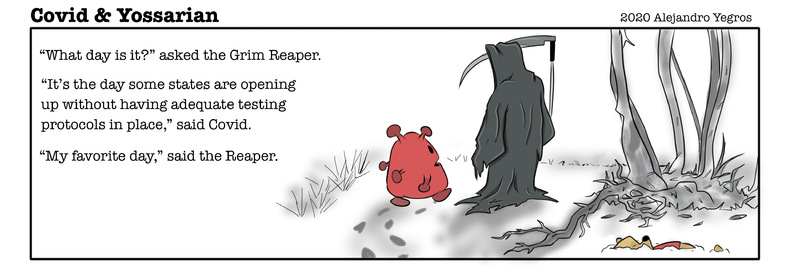
2020-04-30
A comic strip about Covid-19
-
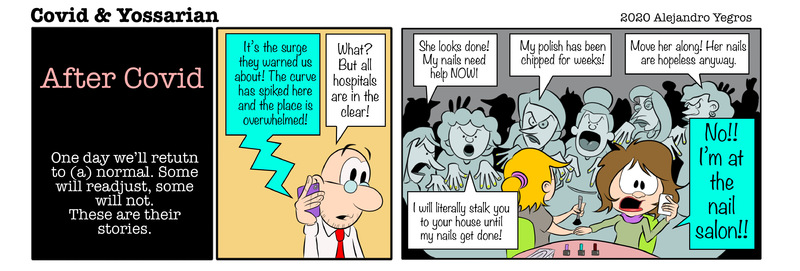
2020-04-29
A comic strip about Covid-19
-

2020-04-28
A comic strip about Covid-19
-
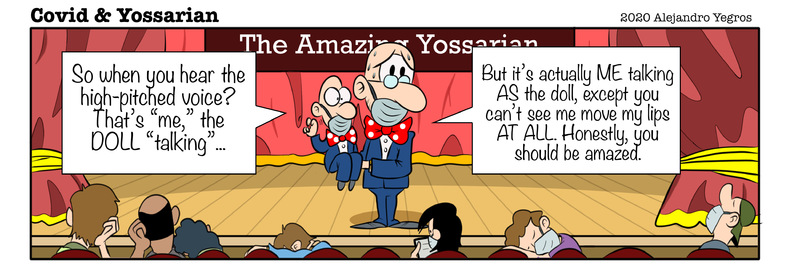
2020-04-27
A comic strip about Covid-19
-
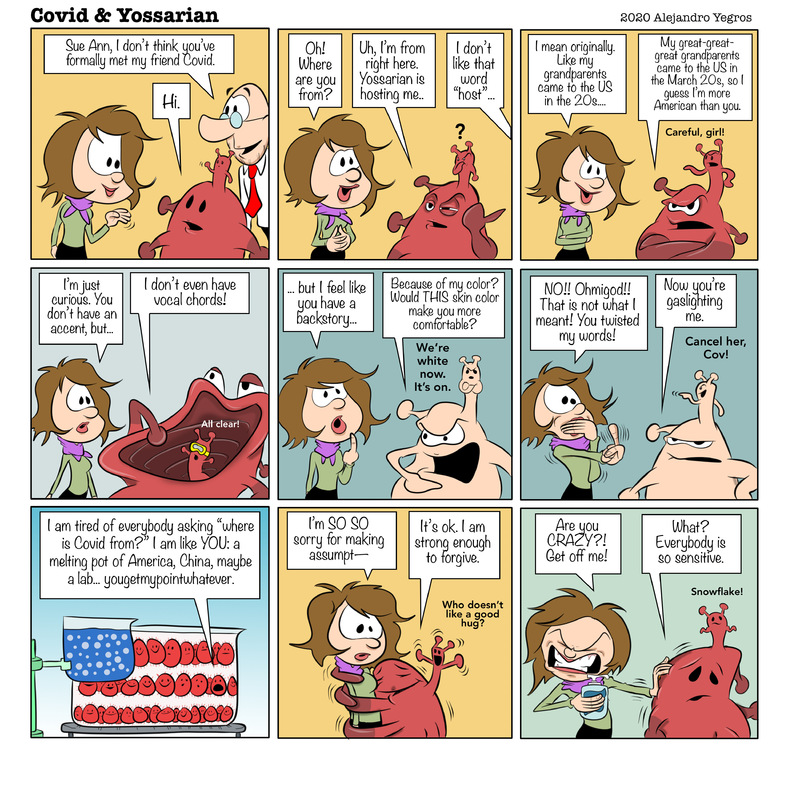
2020-04-26
Covid and Yossarian Episode 40, A comic strip about Covid-19
-
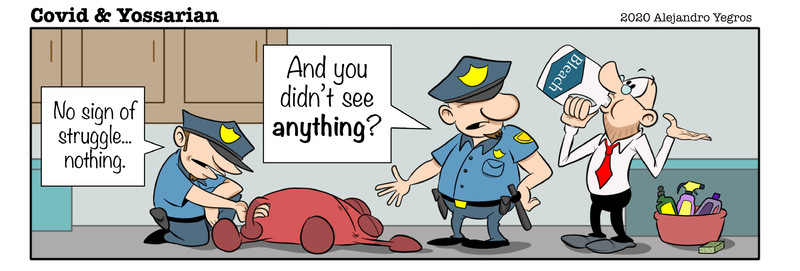
2020-04-25
A comic strip about Covid-19
-
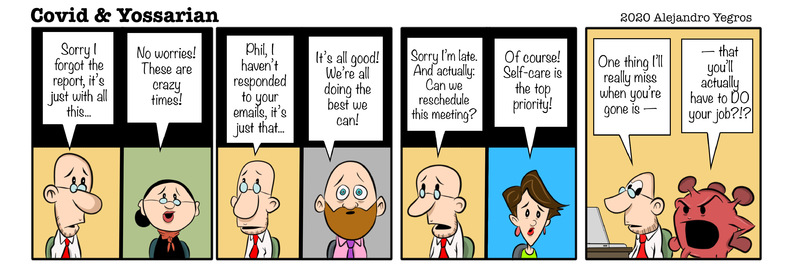
2020-04-24
A comic strip about Covid-19
-
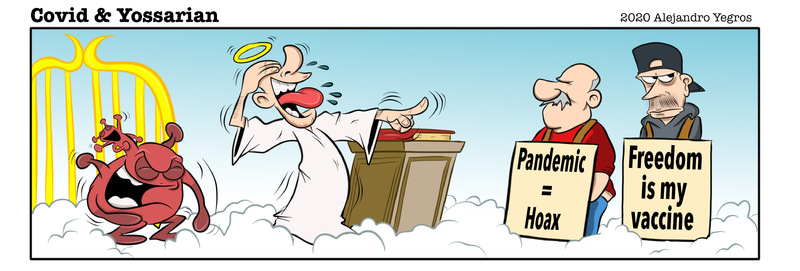
2020-04-23
A comic strip about Covid-19
-
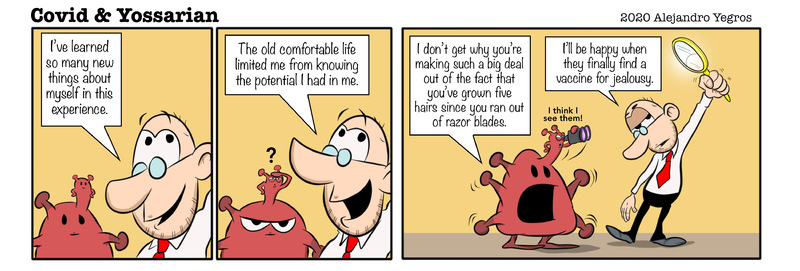
2020-04-21
A comic strip about Covid-19
-
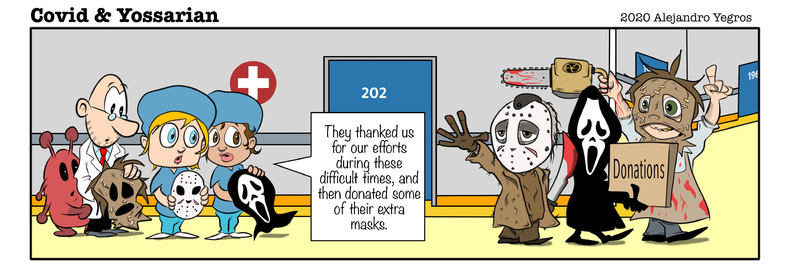
2020-04-21
A comic strip about Covid-19
-

2020-04-20
Covid and Yossarian Episode 34, A comic strip about Covid-19
-

2020-04-19
A comic strip about Covid-19
-
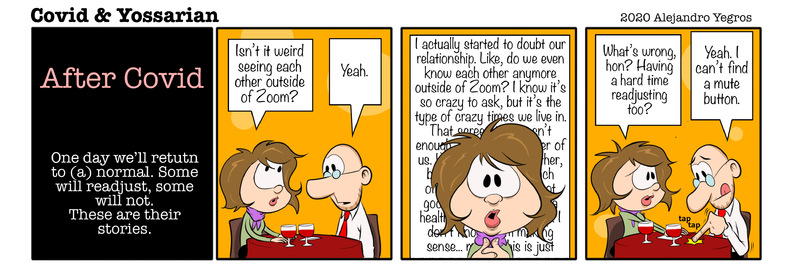
2020-04-18
A comic strip about Covid-19
-
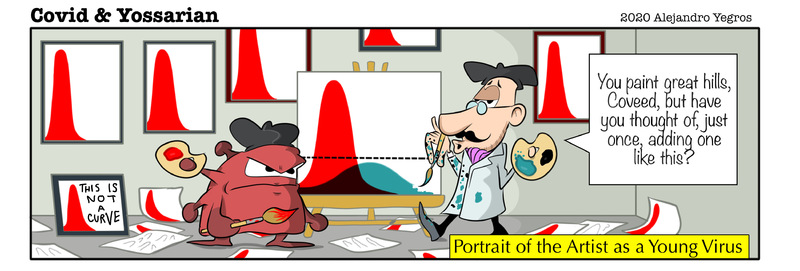
2020-04-17
A comic strip about Covid-19
-
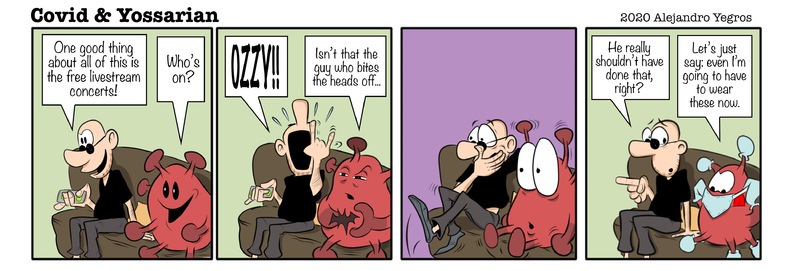
04/16/2020
A comic strip about Covid-19
-
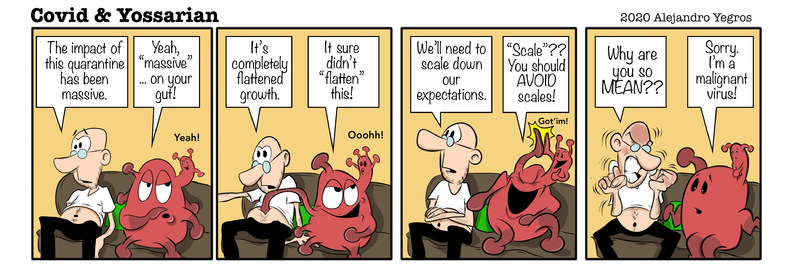
2020-04-15
A comic strip about Covid-19
-

2020-04-14
A comic strip about Covid-19
-
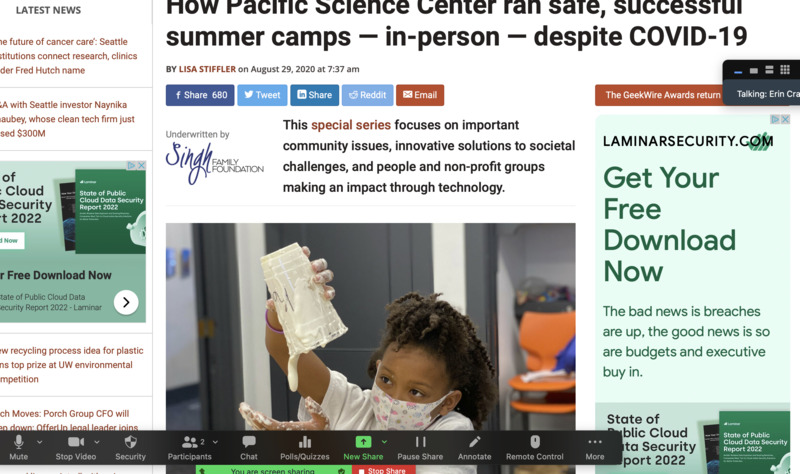
2020-08-29
The attached article is something that is probably not well known. In Seattle, Washington there is the Pacific Science Museum, a fun educational museum for all ages, but focused on kids. Every summer they run educational camps for K-8 graders. It was unclear if after months of distance learning (early pandemic, 2020) students would be physically or emotionally ready to do a group activity in person. PacSci’s camps were able to run while students were socially distanced and masked. This matters because there has been a lot of rhetoric about kids not being able to wear masks for a variety of reasons, but this article proves that kids were able to understand social distancing and mask-wearing so they could have a safe and fun thing to do. With these practices in place, combined with low group sizes, and the use of a lot of outdoor time, they didn’t have any transmission cases for the whole summer. Not included in the article but they had the same success the next summer, 2021, and are on track to continue again the summer of 2022. The significance is not just to a collection focused on children, but also to the service industry since this is a less formal education setting that leans more toward front-facing customer service.
-

2020-07-03
The attached article is about a plant nursery in Snohomish, Washington that banned its employees from wearing face masks on June 3, 2020. This business did not take safety precautions for its employees seriously, and actively encouraged and promoted unsafe practices. This is something that is worth being documented in the JOPTY due to the fact that the stereotype of Western Washington state is that it is very liberal, very progressive. But there are still many pockets of areas that still are not. It’s important to remember that this stereotype isn’t true. I think this is also something that is another example of the general public not taking the lives and significance that service industry/customer service workers seriously.
-
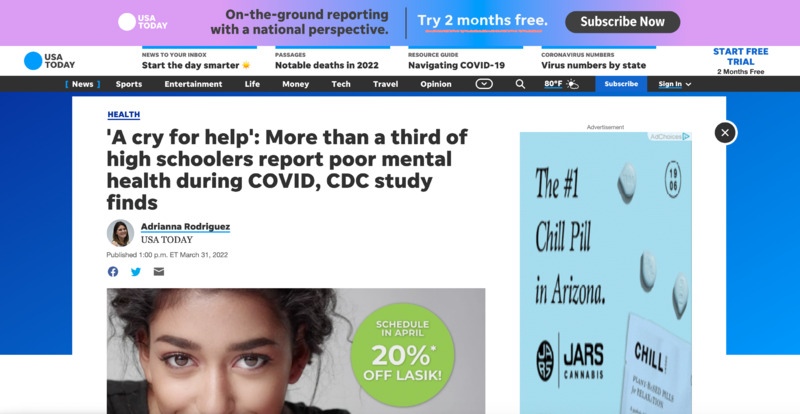
2022-03-31
This is a story from USA Today by Adrianna Rodriguez. This is about the mental health in teens during the pandemic and how it has affected them. The CDC study that is cited says that 44% of high schoolers reported feeling persistently sad or helpless during 2021. Over half of the students surveyed were reported to have experienced emotional abuse from a parent, with 11% saying they have experienced physical abuse. Nearly 30% of students reported a parent or another adult in their house had lost a job. In a demographics breakdown, LGBT students reported more suicide attempts and poorer mental health than their counterparts. One third of students say that they have experienced racism. This article is meant to help show the impact COVID has had on people and the way lockdowns have impacted high schoolers specifically.
-
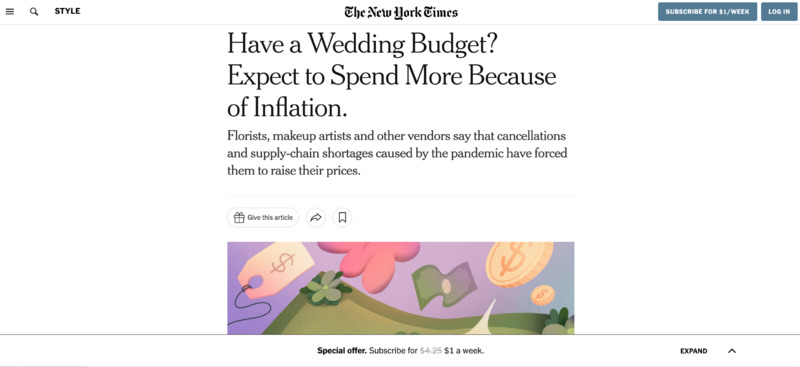
2022-03-30
This story from the New York Times by Danielle Braff talks about the rising costs of weddings as a result from COVID. Couples mentioned in this story go on about how just the basics are more expensive than they used to be. Ms. Alvear-Beceiro and Mr. Klebba, despite not spending extra on things like food, decorations, and music, had a wedding budget that topped $30,000. Zola, a wedding planning site, said that a third of the 468 participating vendors had losses of $50,000 or more due to couples postponing weddings in 2020. Supply chain shortages later on have also helped increase the overall costs, and many businesses are still trying to operate to pre-pandemic levels. Due to rising costs, some couples are choosing to scale back the festivities. Shannon Bernadin, after looking at the costs of wedding venues with her husband, decided to have a wedding at a friend's house and use thrifted outfits, along with homemade decor. All in all, this article demonstrates the changing economy and how that has impacted the wedding industry and how people plan weddings.
-
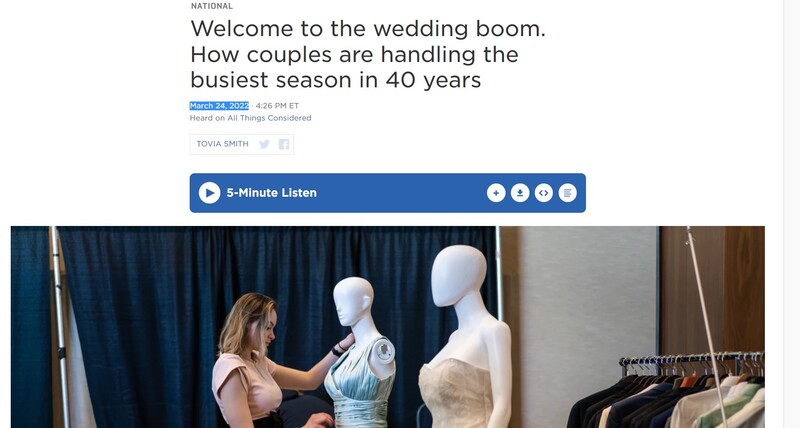
2022-03-24
This is a news story about the rising amount of weddings happening in 2022 after some couples have had to put them off. This story by NPR details changing wedding trends along with it. Wedding dress retailers such as David's Bridal say the demand for maternity wedding dresses is at a 10% increase. Wedding site, The Knot, has had a 25% increase. Financial stress in planning these weddings has also increased. Mandy Connor, a wedding planner, notes that one of her clients was hit with a 30% increase in overall cost between the contracted estimate and the final bill. This article does a good job at showing changes in wedding trends based on how retailers are reacting.
-
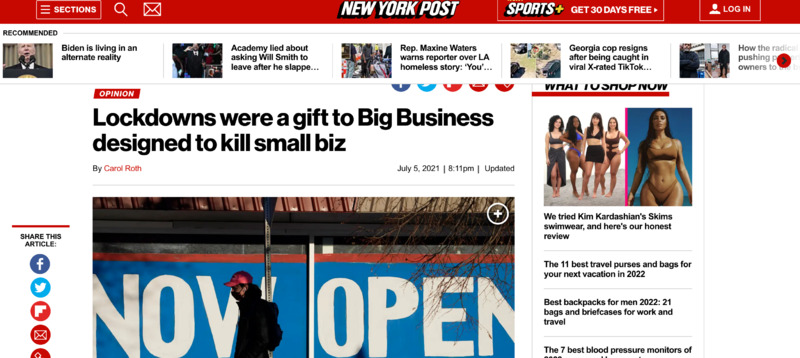
2021-07-05
This is an opinion piece by Carol Roth for the New York Post. This news story is about ways in which the lockdowns in 2020/2021 hurt small businesses, but helped big businesses. Roth claims that during the pandemic, small businesses are hitting half or less than half of their pre-lockdown revenue. Some businesses, Roth claims, possibly won’t recover at all. This article says that in 2020, the Hamilton Project accounted for 400,000 closures. I find this article to be important, as I think the business side of the pandemic needs to be told more, as these effects on small businesses impact the local and state economies, in addition to what jobs are available for people looking to go back to work after lockdowns end.
-

2022-03-31
This is an opinion piece by Erin Loder for the Pacific Daily News. This opinion piece details the benefits that COVID-19 has brought for working mothers. Loder, a working mother herself, describes having a more flexible schedule to help take care of kids. She says that in the workforce, women often get penalized for having kids much more often than men do, and with working from home, she is allowed to take more time for her kids and save money by not having to pay for daycare as often. Overall, she sees this as a positive turn for working mothers, since the pandemic has given women opportunities to raise their families more as they work. I found this opinion piece a nice take, as it brings out some of the positives women have experienced due to changes having to be made in work-life balance for many people out there.
-
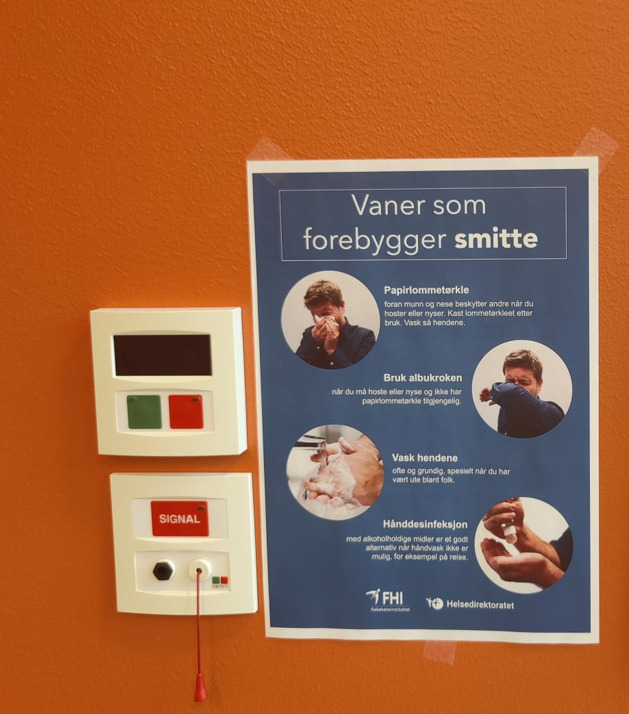
2022-03-16
This sign is located in the staff area of St. Olav's Hospital in Trondheim, Norway. This photo was taken on March 16th, 2022 inside of a staff-only area.
The sign reads as follows:
Habits that prevent infection
Paper tissues
Cover your mouth and nose to protect others when coughing or sneezing. Through away the tissue after use. Then wash your hands.
Use the hook of your elbow
When you need to cough or sneeze and you do not have a paper tissue.
Wash your hands
With hand sanitizer when hand washing is not possible; for example, when traveling.
In 2022, many places in the world have taken down signs and other precautionary rules that have to do with limiting the spread of coronavirus. This sign, which can only be seen by hospital staff, shows how precautions are still being enforced for hospital staff. This is important as it shows what rules and regulations are still being enforced in 2022.
-
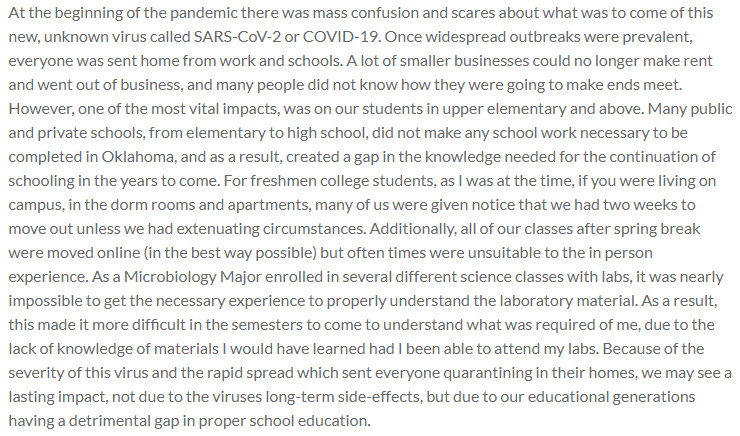
2022-03-30
At the beginning of the pandemic there was mass confusion and scares about what was to come of this new, unknown virus called SARS-CoV-2 or COVID-19. Once widespread outbreaks were prevalent, everyone was sent home from work and schools. A lot of smaller businesses could no longer make rent and went out of business, and many people did not know how they were going to make ends meet. However, one of the most vital impacts, was on our students in upper elementary and above. Many public and private schools, from elementary to high school, did not make any school work necessary to be completed in Oklahoma, and as a result, created a gap in the knowledge needed for the continuation of schooling in the years to come. For freshmen college students, as I was at the time, if you were living on campus, in the dorm rooms and apartments, many of us were given notice that we had two weeks to move out unless we had extenuating circumstances. Additionally, all of our classes after spring break were moved online (in the best way possible) but often times were unsuitable to the in person experience. As a Microbiology Major enrolled in several different science classes with labs, it was nearly impossible to get the necessary experience to properly understand the laboratory material. As a result, this made it more difficult in the semesters to come to understand what was required of me, due to the lack of knowledge of materials I would have learned had I been able to attend my labs. Because of the severity of this virus and the rapid spread which sent everyone quarantining in their homes, we may see a lasting impact, not due to the viruses long-term side-effects, but due to our educational generations having a detrimental gap in proper school education.
-
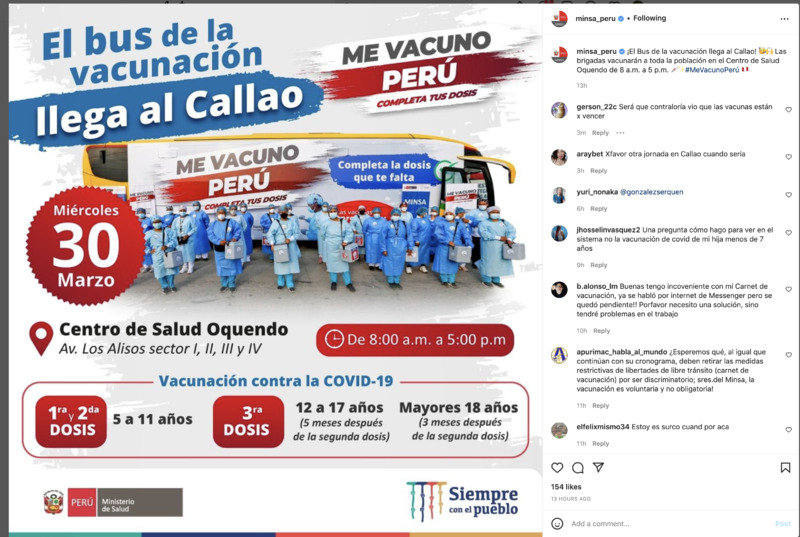
2022-03-30
This Instagram posts shows that today, all day (8-5) people in Callao can head to the Centro de Salud Quendo to receive the COVID vaccine dose that they need. Children 5-11 can get their first or second dose and children 12-17 can get their 3rd dose 5 months after the second dose, and those over 18 can get their 3rd dose 3 months after the second one. The photo show s a bus that is carrying healthcare workers to the destination to help vaccinate the people there.
-
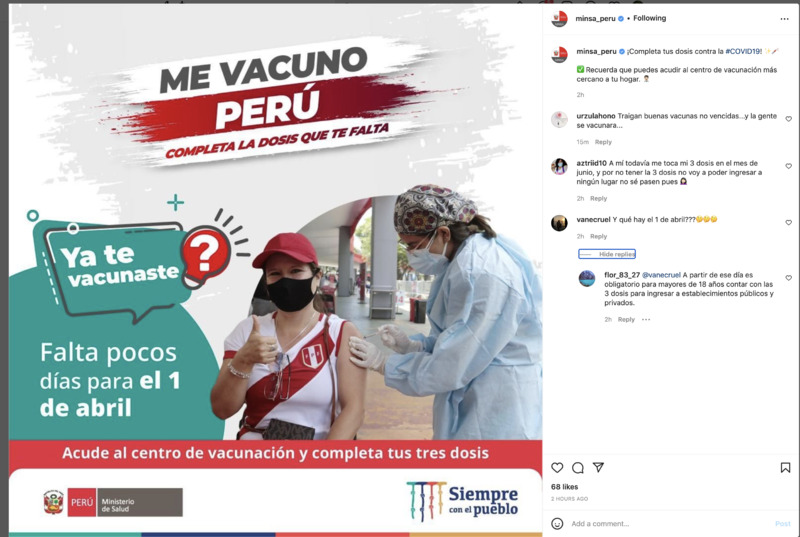
2022-03-30
This Instagram post from the ministry of Peru lets people know that they need to head to a vaccination center to receive their 3rd dose of the COVID-19 vaccine. A commenter asked what happens after April 1st? And someone responds that after April 1st it is obligatory for adults over 18 years old to have 3 COVID shots.
-
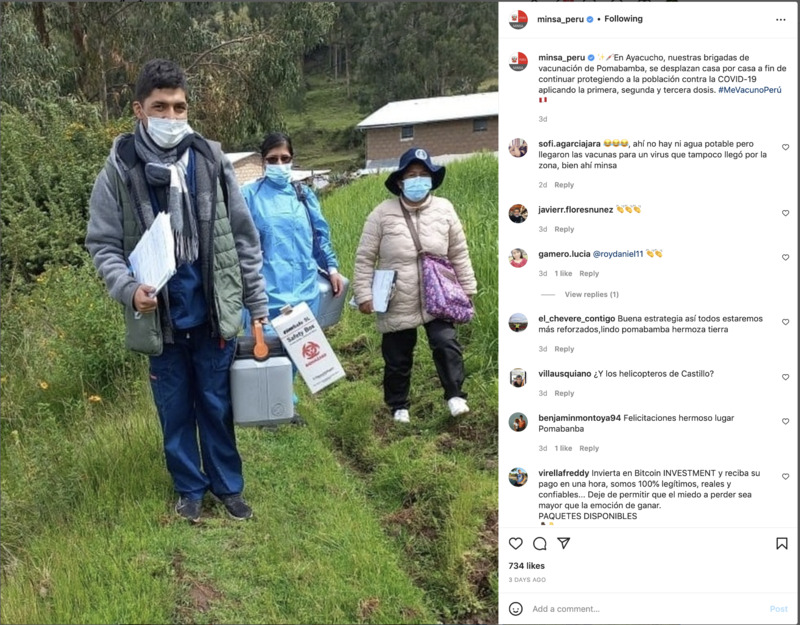
2022-03-27
The ministry of Peru is launching efforts to vaccinate people living in rural regions. This Instagram post shows a crew of three people carrying coolers of vaccines to rural areas in Peru.
-
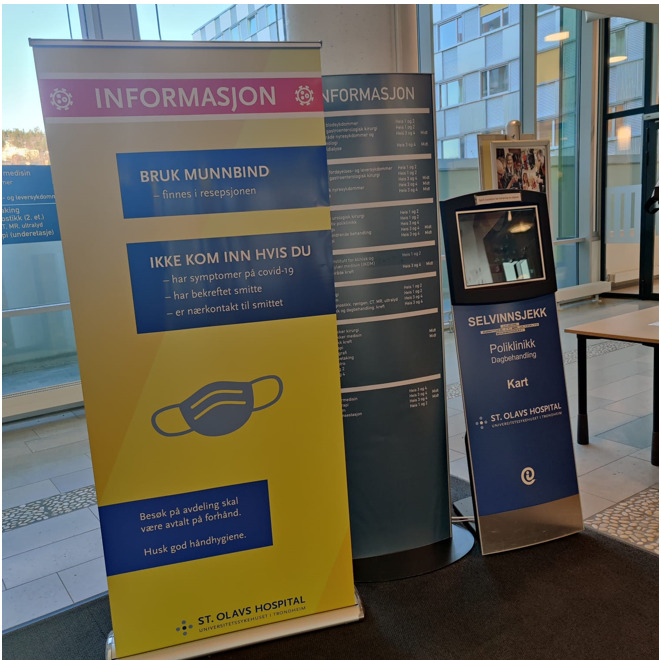
2022-03-16
This photo was taken in the lobby of St. Olav's Hospital in Trondheim, Norway on March 16th, 2022. The signs reads as follows:
INFORMATION
WEAR A MASK
- Available at the front desk
DO NOT ENTER IF YOU
- Have symptoms of COVID-19
- Tested positive for COVID-19
- Had contact with a corona positive patient
Please arrange visits with the ward in advance.
I believe that this is important because this shows have precautions are being taken in the hospital in 2022. In many parts of the world, two years into the pandemic, a lot of rules and regulations regarding the prevention of COVID-19 have relaxed. In some cases, there are no precautions at all. This sign shows have precautions are still being taken in a major hospital by requiring masks and asking people who have been exposed to not enter the hospital.
-

2022-03-25
A news article from NPR talks about the parents of 12 children that challenged the newly signed law by Governor Glenn Youngkin to halt the enforcement of that law because it violated the children's rights under the federal American with Disabilities Act. This law would only give parents the right to choose for their own children. The group of parents have kids with health conditions that range from asthma to cystic fibrosis, which put them at heightened risk for COVID-19. What about other kids that have health conditions that make them a heightened risk for COVID whose parents didn't say their federal rights were violated?
-
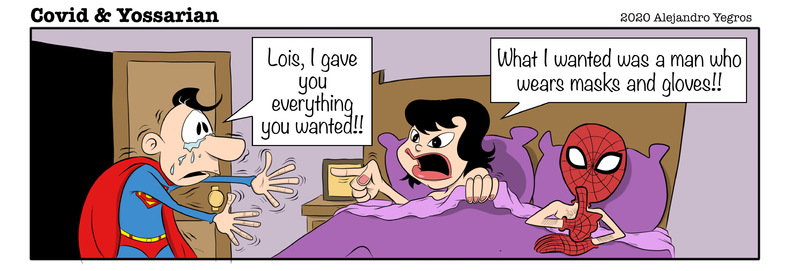
2020-04-13
A comic strip about Covid-19
-
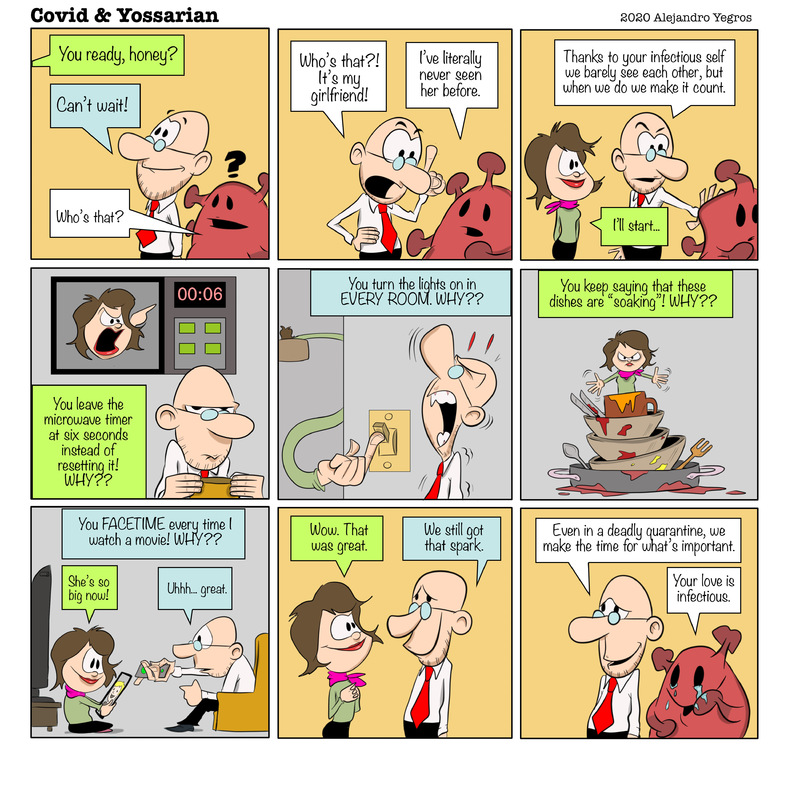
2020-04-12
A comic strip about Covid-19
-
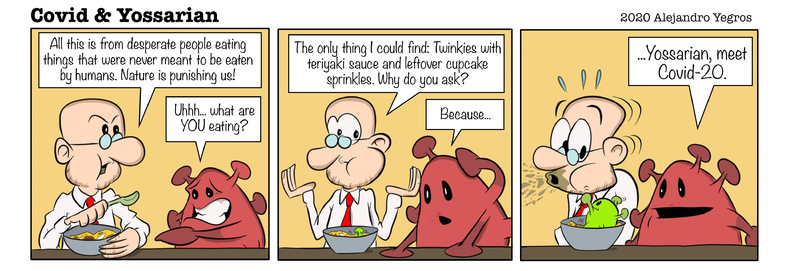
2022-04-11
A comic strip about Covid-19
-
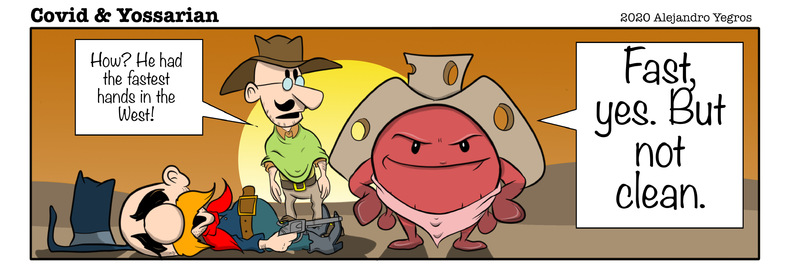
2020-04
A comic strip about Covid-19
-
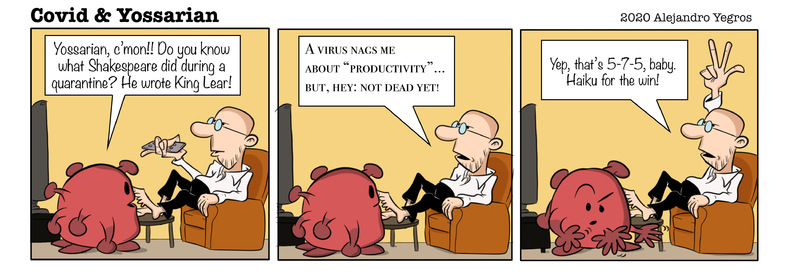
2020-04-09
Covid and Yossarian Episode 23, A comic strip about Covid-19
-
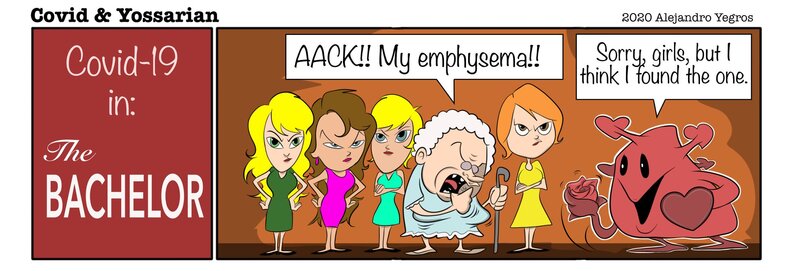
04/08/2020
A comic strip about Covid-19
-

2020-04-07
A comic strip about Covid-19
-
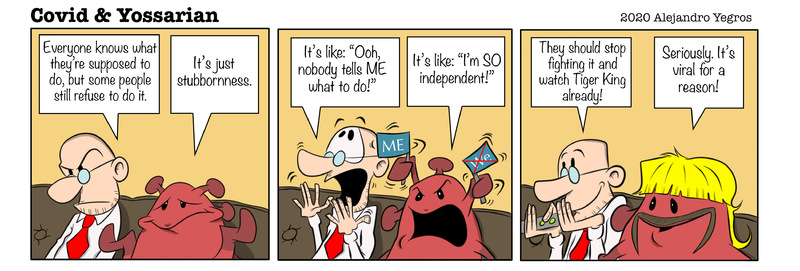
2020-04-06
A comic strip about Covid-19
-
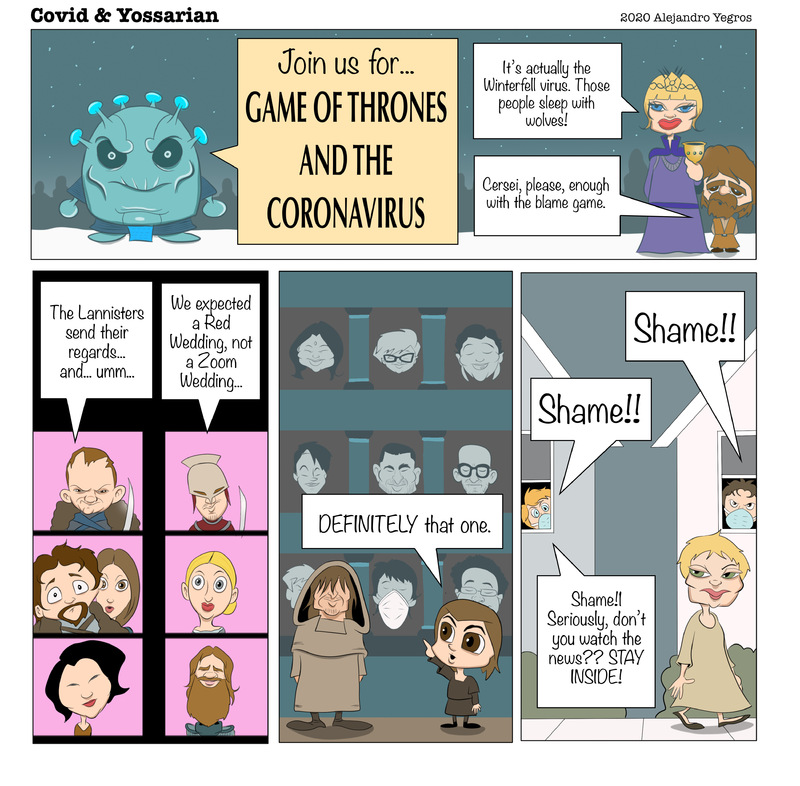
2020-04-05
A comic strip about Covid-19
-
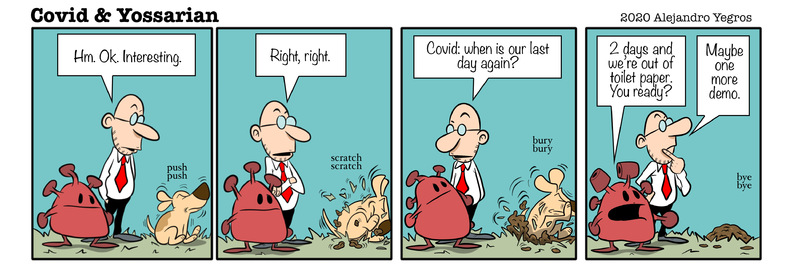
2020-04-04
A comic strip about Covid-19
-
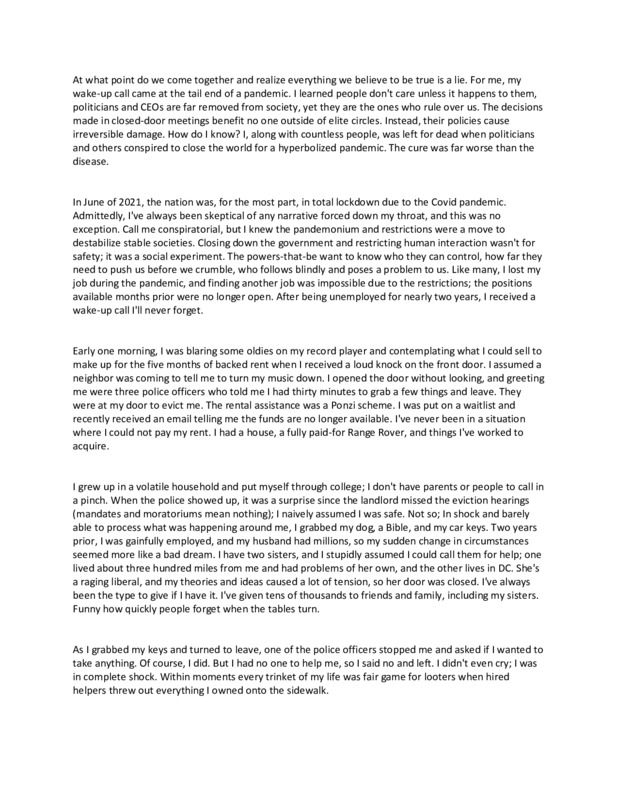
2022-03-28T08:40
My personal experience
-
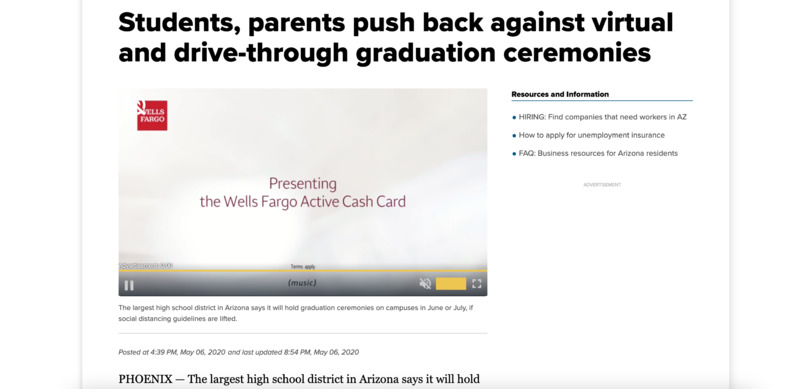
2020-05-06
My oldest daughter is now a senior in high school, and she is still pretty upset that she didn’t get to have a junior prom. She understands that in the context of everything happening in the world, it’s not the most important or most tragic thing that could happen, but it still stings. For many students, it’s the milestones like prom and graduation that make the whole four years worthwhile. If the milestones that high school students look forward to can’t be held, it can affect them deeply. As schools closed and Covid-19 became a fixture in our everyday lives, school events like sports, proms, and graduations went away. Some schools held virtual graduations featuring videos and speeches over Zoom. Others attempted to maintain an atmosphere of celebration by holding drive-up graduations with decorated cars and parking lots. However, many students and parents were upset by this change. While this is understandable, most school districts prioritized the health and safety of students, families, and staff over having an in-person ceremony. This article helps to capture some of the frustrations seniors expressed in 2020 when their hopes of walking the stage and receiving their diploma seemed to vanish overnight.
-
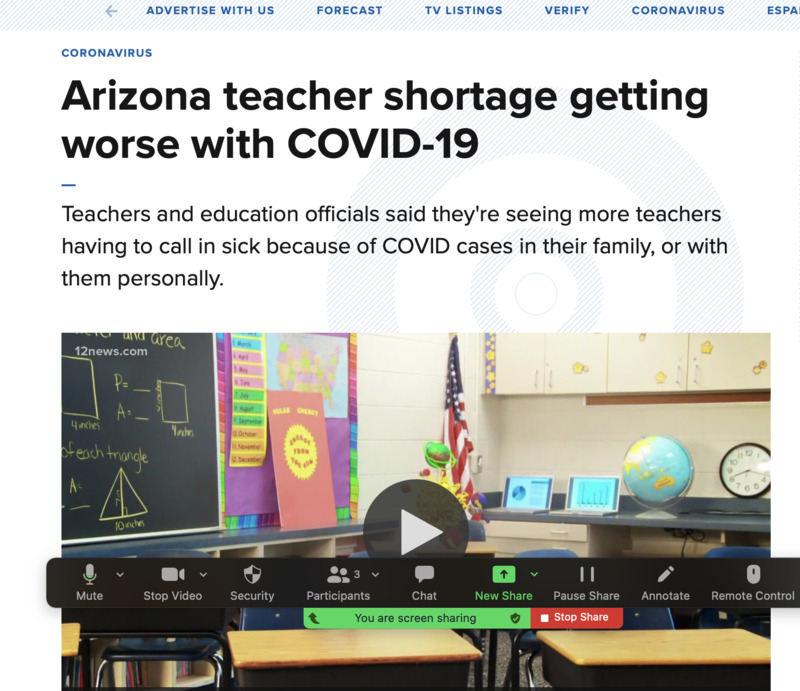
2022-01-11
Arizona teachers have struggled with obtaining higher pay and better funding for years. Add to that a legislative body that doesn’t prioritize educational funding, improving teaching conditions or student learning. When Covid-19 reared its ugly head, the pressure public school teachers normally deal with in overcrowded, undersupplied classrooms intensified and – for many overworked teachers – this was the last straw. Teachers who were in a position to took early retirement. Others simply left the profession for the private sector. Still, some remained and adapted to whatever model of learning their school district employed – sometimes on a week-to-week basis. Now that most schools have returned to an in-person modality, teachers are still leaving the classroom. This article sheds lights on the teacher shortage and how, even still, Arizona educators are contending with Covid-19 in their classrooms and families, leading them to reconsider their decision to stay in education.
-
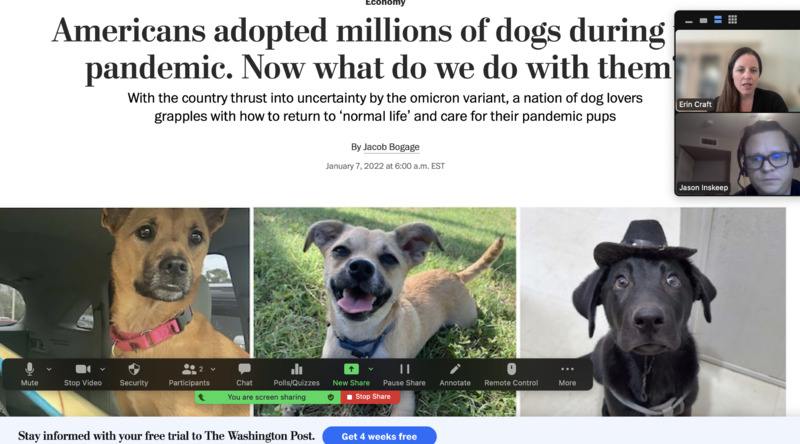
2022-01-07
As one of many people who adopted a pet during the pandemic, this article resonated with me in many ways. It discusses how people transitioning from remote work at home and returning to the office are trying to ensure that the change is smooth for their newly acquired pets as well. Many of the pets – especially dogs – are not accustomed to being left along for lengths of time and are experiencing separation anxiety. As a result, some pet owners are trying to ensure that their animals have care while they at work. Unfortunately, this is easier said than done due to overbooked facilities and some animals with behavioral issues due poor socialization as a result of the pandemic. This article does a nice job capturing some of the struggles pet owners are experiencing now as they attempt to return to normalcy and some of the services available to keep them happy and occupied as they adjust.
-
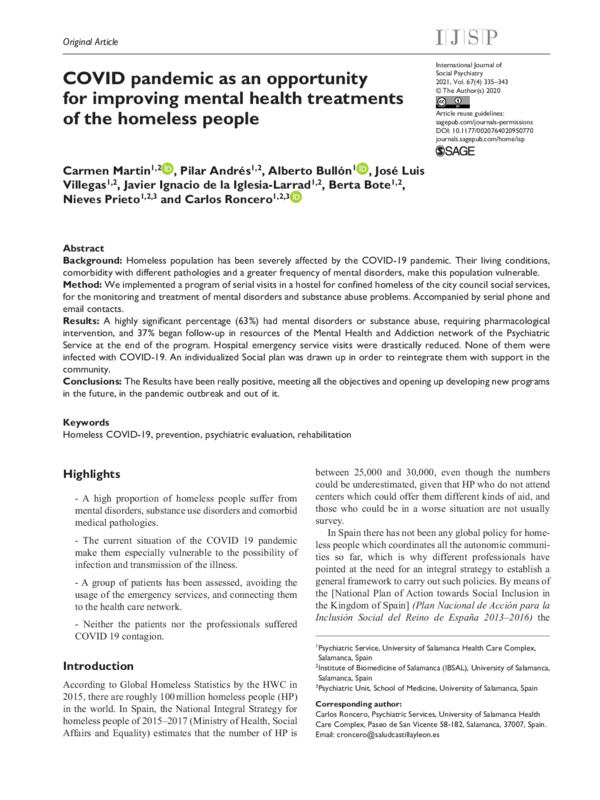
2021-06-27
While the COVID-19 pandemic has drastically altered mental health, see https://covid-19archive.org/s/archive/page/mental-health, I hope that there could be benefits to mental health as COVID rates around the world drop. It is now more convenient than ever to partake in counseling services from the comfort of your room, especially if you have social anxiety or pandemic anxiety. Unfortunately, statistics are not out as of March 2022 that demonstrate that mental health is improving with waning COVID rates, instead counselors, psychiatrists, and psychologists seem busier than ever. While telehealth meetings are convenient, wait times and schedules are full of the backlog of people whose mental health was affected by the pandemic.
I wanted to find an example of a positive outcome on mental health through COVID's global sweep, especially as COVID wanes. Attached is an example of a study in Spain that focused on a group of homeless in Spain that were in lockdown. "More than 60% of them presented mental disorders and within 8 weeks they were visited in person 2–3 times...Finally, 51.8% were linked to social and health care services and 37% to mental health resources, which can constitute a step forward in their reintegration and normalization." They argue that if it was not for COVID and these efforts, these homeless people may not have been diagnosed and helped. The paper concludes that this study is useful for the future because it shows how under immensely stressful situations, primary and secondary interventions worked. This can be repeated without a pandemic.
While the pandemic was very stressful, it reaped some benefits such as a new focus on mental health, new methods of talking with trained professionals, and studied like this that show data of improving mental health in times of stress.
-
2022-03-27
Although my aunt was not a significant part of my life since about 2007, she was still family. During the midst of the large outbreak in the summer of 2020 my dad texted me that she was in the hospital, then was released, and then was found deceased in her home a few days later. At this time, it was hard to have a body “processed” quickly, for lack of better words, through morgues and funeral homes. Additionally, having a funeral service was not advised because of either lockdown, funeral homes limiting attendance, or these homes even not performing services. On top of that, many people would have been hesitant to attend. My dad and his siblings decided to not have a service. I have heard many other similar stories. Perhaps this became a pandemic funerary custom to some; life went on and no occasion was marked. Even though we were not super close, and I was not despondent, this would have been a way to process and mark a death for me. For others, a time to process grief.
To summarize, she died of COVID-19. I could not visit her in the hospital, and we did not have a funeral service or a burial. I feel that because of the pandemic my family did not go through the traditions and customs that help people process and accept death. I am not sure how my parents and sister feel. I have mistakenly wondered what my aunt was up to, temporarily forgetting her death. Even though we weren't the closest I would have had a memory marker achieved through tradition and grieving/funerary customs that would have given others the peace needed.
-

2021-03-01
This article details the closing of the popular Mesa concert venue Club Red during March of 2021. Unfortunately, due to an inability to host concerts as a result of COVID-19, Club Red ran out of business and had to close its doors after 15 years of music. Club Red was the first notable local music venue to close in the wake of the pandemic, and it made me sad personally because my own band used to play shows there. I have had the privilege to interact with Kimberly LaRowe of 13th Floor Entertainment, who is featured in the article, on several occasions to book shows for my band, and I never had a bad experience. While it is not explicitly stated that Club Red closed as a result of COVID-19, it his highly likely, as suggested by Kimberly LaRowe in the article. This article does an excellent job of diving deep into how drastically the local Arizona music scene has been affected by COVID-19, especially venue owners and promoters. Also, this article provides a very interesting story of the history of Club Red over the years, and details the subsequent reactions that many local and prominent musicians had to the venues closing, which certainly adds to the archives performing arts collection
-

2020-12-04
This remarkable article tells the story of how a 104-year-old World War II veteran from Alabama named Major Wooten was able to beat COVID-19 in a little under two weeks after testing positive. The article describes how Major Wooten was given an infusion of a newly approved monoclonal antibody therapy named bamlanivimab, and while this treatment physically drained him temporarily, he was able to recover 24 hours later. Wooten maintains that he is still quite drained and “mentally fuzzy” after having COVID-19, but this remarkable man was able to bounce back extremely well from the disease. This article is significant to the archival collection relating to COVID-19 survivors, as well as the collection pertaining to veterans. It truly is amazing to see someone like Major Wooten survive fighting in France during World War II, and then continue to beat the odds by defeating such a deadly disease. This article will do a great job of addressing the lack of input within the archives from elderly veterans on how the COVID-19 pandemic impacted their lives.
-
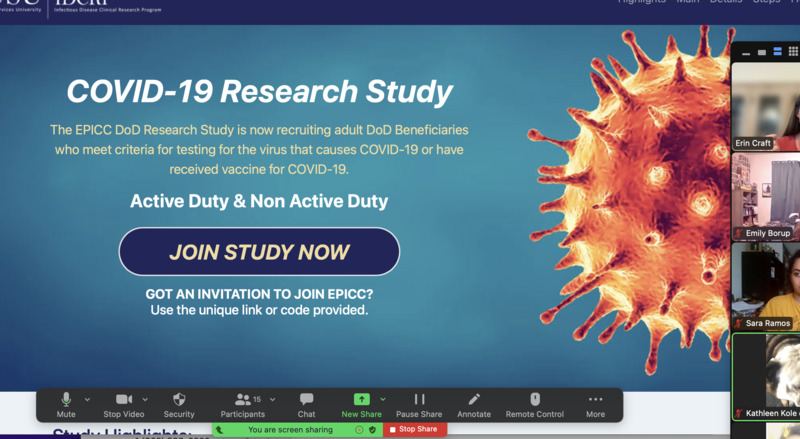
2022-03-27
In October 2021 I was selected to voluntarily participate in the EPICC DoD Research Study on COVID-19. This study is focused on adulty active duty and non-active duty military service members who have tested for, had, or is vaccinated against COVID-19, and part of the Military Health System. I had never participated in a study before and honestly what hooked me was the $10 Amazon gift card they would give us for participating.
Fast forward six months and I have completed three questionaries and one at-home blood sample kit. I think it's pretty cool to be participating in something that may improve the Military Health System overall and also provide data points for future research of COVID-19. Studies like this show how novel this virus really was and how we want to learn as much as we can about it in an effort to be more prepared for similar events in the future.
 2020-04-30
2020-04-30 2020-04-29
2020-04-29 2020-04-28
2020-04-28 2020-04-27
2020-04-27 2020-04-26
2020-04-26 2020-04-25
2020-04-25 2020-04-24
2020-04-24 2020-04-23
2020-04-23 2020-04-21
2020-04-21 2020-04-21
2020-04-21 2020-04-20
2020-04-20 2020-04-19
2020-04-19 2020-04-18
2020-04-18 2020-04-17
2020-04-17 04/16/2020
04/16/2020 2020-04-15
2020-04-15 2020-04-14
2020-04-14 2020-08-29
2020-08-29 2020-07-03
2020-07-03 2022-03-31
2022-03-31 2022-03-30
2022-03-30 2022-03-24
2022-03-24 2021-07-05
2021-07-05 2022-03-31
2022-03-31 2022-03-16
2022-03-16 2022-03-30
2022-03-30 2022-03-30
2022-03-30 2022-03-30
2022-03-30 2022-03-27
2022-03-27 2022-03-16
2022-03-16 2022-03-25
2022-03-25 2020-04-13
2020-04-13 2020-04-12
2020-04-12 2022-04-11
2022-04-11 2020-04
2020-04 2020-04-09
2020-04-09 04/08/2020
04/08/2020 2020-04-07
2020-04-07 2020-04-06
2020-04-06 2020-04-05
2020-04-05 2020-04-04
2020-04-04 2022-03-28T08:40
2022-03-28T08:40 2020-05-06
2020-05-06 2022-01-11
2022-01-11 2022-01-07
2022-01-07 2021-06-27
2021-06-27 2021-03-01
2021-03-01 2020-12-04
2020-12-04 2022-03-27
2022-03-27